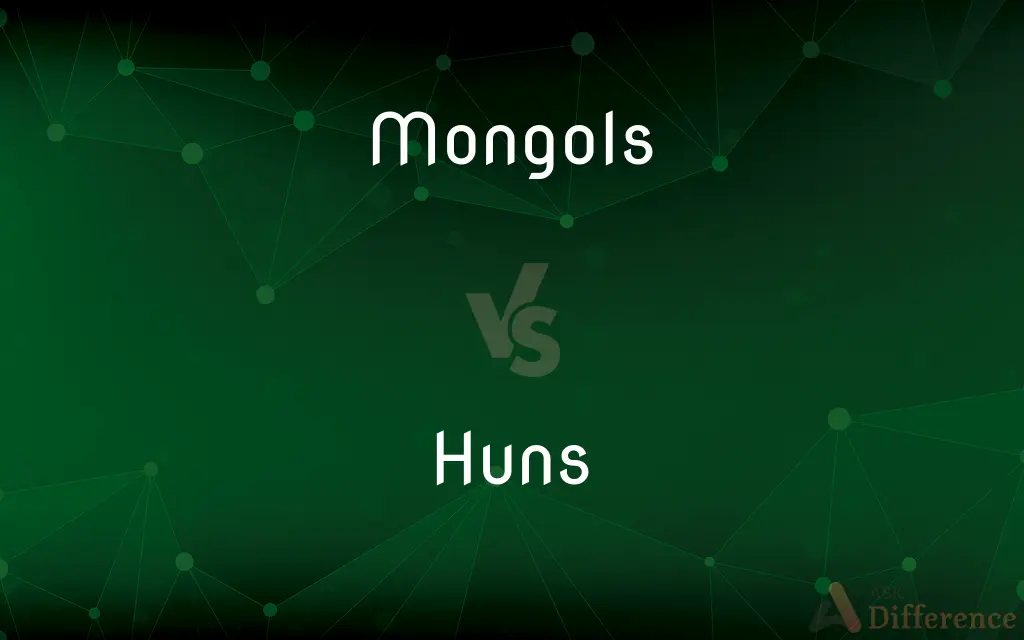Mongols vs. Huns — What's the Difference?
Edited by Tayyaba Rehman — By Fiza Rafique — Updated on September 25, 2023
The Mongols, led by figures like Genghis Khan, originated in Central Asia and built a vast empire in the 13th century. The Huns, earlier nomads, migrated to Europe around the 4th century, clashing with the Roman Empire.

Difference Between Mongols and Huns
Table of Contents
ADVERTISEMENT
Key Differences
The Mongols, originating from the Central Asian steppes, emerged as a dominant force in the 13th century under the leadership of Genghis Khan. Their prowess in warfare, combined with an extensive spy network, allowed them to establish the largest contiguous land empire in history. In contrast, the Huns, while also a nomadic group, made their mark several centuries earlier. Around the 4th and 5th centuries, they moved into Eastern and Central Europe, instigating significant upheaval in the region.
While the Mongols are often associated with their remarkable conquests in Asia, the Middle East, and even parts of Eastern Europe, their governance was noted for relative tolerance in religion and an embrace of various cultures within their territories. The Huns, on the other hand, are largely known for their invasions of the Roman Empire. Their aggressive tactics and the fear they instilled led to significant historical narratives, particularly from Roman sources.
An essential figure for the Mongols is Genghis Khan, whose strategic mind, combined with a meritocratic military structure, facilitated their rapid expansion. For the Huns, Attila stands out. Often dubbed "Attila the Hun", he led numerous campaigns against both the Eastern and Western Roman Empires, becoming one of history's most iconic invaders.
Comparison Chart
Origins
Central Asia
Likely from Central Asia or the Altai region
Era of Prominence
13th-14th century
4th-5th century
ADVERTISEMENT
Notable Leader
Genghis Khan
Attila
Territories
Asia, Middle East, parts of Europe
Eastern and Central Europe
Decline
Fragmentation into various Khanates
Rapid disintegration post-Attila
Compare with Definitions
Mongols
Adopters of various religions and patrons of culture and trade.
The Mongols embraced religious tolerance and supported the Silk Road trade.
Huns
A nomadic group that invaded parts of Europe in the 4th and 5th centuries.
The Huns' sudden appearance in Europe created significant disturbances.
Mongols
A Central Asian ethnic group known for their vast empire in the Middle Ages.
The Mongols, under Genghis Khan, conquered vast territories across continents.
Huns
Often depicted as fierce warriors in historical narratives.
Roman sources frequently portrayed the Huns as barbaric invaders.
Mongols
Divided into various clans and later, Khanates.
The Mongol Empire eventually fragmented into several Khanates.
Huns
Possessed unique warfare strategies and weapons.
The Huns' composite bows were a formidable asset in battles.
Mongols
Rulers of the largest contiguous empire in history.
The Mongols' empire spanned from China to Eastern Europe.
Huns
Known for their conflicts with the Roman Empire.
The Huns, under Attila, became a major threat to the Romans.
Mongols
The Mongols (Mongolian: Монголчууд, ᠮᠣᠩᠭᠣᠯᠴᠤᠳ, Moŋğolçuud, [ˈmɔɴ.ɢɔɬ.t͡ʃot]; Chinese: 蒙古族; Russian: Монголы) are an East Asian ethnic group native to Mongolia, Inner Mongolia in China and the Buryatia Republic of the Russian Federation. The Mongols are the principal member of the large family of Mongolic peoples.
Huns
Disintegrated rapidly after Attila's death.
The power and influence of the Huns waned quickly post-Attila.
Mongols
A member of any of the traditionally nomadic peoples of Mongolia.
Huns
The Huns were a nomadic people who lived in Central Asia, the Caucasus, and Eastern Europe between the 4th and 6th century AD. According to European tradition, they were first reported living east of the Volga River, in an area that was part of Scythia at the time; the Huns' arrival is associated with the migration westward of an Iranian people, the Alans. By 370 AD, the Huns had arrived on the Volga, and by 430 the Huns had established a vast, if short-lived, dominion in Europe, conquering the Goths and many other Germanic peoples living outside of Roman borders, and causing many others to flee into Roman territory.
Mongols
See Mongolian.
Huns
A member of a group of Central Asian nomadic pastoralist peoples who invaded Europe in the fourth and fifth centuries AD and were defeated in 455.
Mongols
(Anthropology) A member of the Mongoloid racial classification.
Huns
Often hun A barbarous or destructive person.
Mongols
Of or relating to Mongolia, the Mongols, or their language or culture.
Huns
Offensive Slang Used as a disparaging term for a German, especially a German soldier in World War I.
Mongols
(Anthropology) Of or relating to the Mongoloid racial classification.
Huns
Plural of hun
Mongols
Plural of mongol
Mongols
One of the great races of man, including the greater part of the inhabitants of China, Japan, and the interior of Asia, with branches in Northern Europe and other parts of the world. By some American Indians are considered a branch of the Mongols. In a more restricted sense, the inhabitants of Mongolia and adjacent countries, including the Burats and the Kalmuks.
Mongols
Renowned horsemen and archers with nomadic traditions.
The Mongols' expertise in cavalry warfare was unparalleled in their time.
Common Curiosities
How vast was the Mongol Empire?
The Mongol Empire is known as the largest contiguous empire in history.
Did the Mongols and Huns exist at the same time?
No, the Huns' prominence was in the 4th-5th centuries, while the Mongols peaked in the 13th century.
Were the Mongols and Huns related?
Both were nomadic groups from Central Asia, but they existed centuries apart and had distinct cultures and histories.
Who was the most famous Mongol leader?
Genghis Khan is the most iconic Mongol leader.
Who was the most renowned Hun leader?
Attila, often called "Attila the Hun", is the most well-known Hun leader.
Did the Mongols and Huns interact?
There's no historical evidence of direct interactions between the two groups.
How did the Huns influence the Roman Empire?
The Huns pressured both the Western and Eastern Roman Empires, leading to strategic and territorial changes.
Why did the Mongol Empire decline?
The vastness of the empire led to fragmentation into various Khanates and internal strife.
How did Attila's death impact the Huns?
After Attila's death, the Huns faced internal divisions and external pressures, leading to their rapid decline.
How did the Mongols manage such a vast empire?
The Mongols established a complex governance system, postal service, and promoted trade and cultural exchange.
Did the Huns have an empire as large as the Mongols?
No, while the Huns had significant influence, their territories were not as expansive as the Mongol Empire.
Were the Mongols known for religious tolerance?
Yes, the Mongols were generally tolerant of various religions within their empire.
Did the Mongols and Huns have similar warfare tactics?
While both were skilled in cavalry warfare, their tactics, weapons, and strategies varied.
Were the Huns the ancestors of the Mongols?
While both originated from Central Asia, they are distinct groups with different timelines and histories.
Were the Mongols and Huns purely war-driven?
While both are known for their conquests, they also had intricate social structures, trade relations, and cultural interactions.
Share Your Discovery

Previous Comparison
Meridian vs. Longitude
Next Comparison
Peroneus vs. FibularisAuthor Spotlight
Written by
Fiza RafiqueFiza Rafique is a skilled content writer at AskDifference.com, where she meticulously refines and enhances written pieces. Drawing from her vast editorial expertise, Fiza ensures clarity, accuracy, and precision in every article. Passionate about language, she continually seeks to elevate the quality of content for readers worldwide.
Edited by
Tayyaba RehmanTayyaba Rehman is a distinguished writer, currently serving as a primary contributor to askdifference.com. As a researcher in semantics and etymology, Tayyaba's passion for the complexity of languages and their distinctions has found a perfect home on the platform. Tayyaba delves into the intricacies of language, distinguishing between commonly confused words and phrases, thereby providing clarity for readers worldwide.
















































